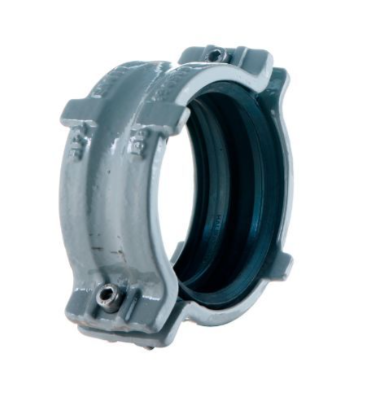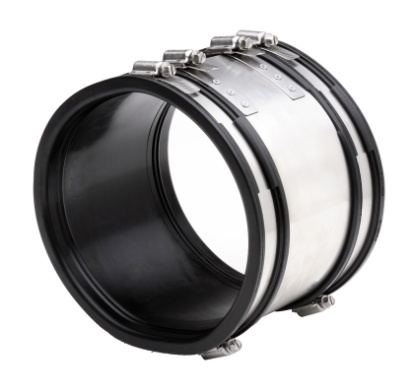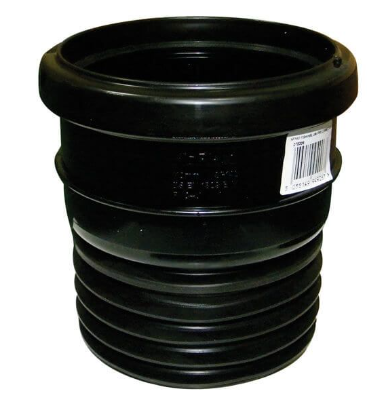How to Connect PVC Drain Pipe to Cast Iron

Are you tackling an underground drainage project that requires connecting a PVC drain pipe to various types of cast iron soil stack or drain lines? Don't worry, this is a common scenario and with the right fittings and techniques, it's an easy job. In this guide, we'll walk through the steps for properly joining PVC to cast iron drain pipes and fittings.
Why Connect PVC to Cast Iron?
Cast iron pipes and fittings have been used for decades in drainage systems due to their durability and longevity. However, modern plumbing often utilises lighter, more affordable PVC pipe. When renovating or adding on, you may need to tie new PVC lines into the existing cast iron drainage system.
Joining Methods
Halifax Drain Ductile Iron Coupling (For Compatible Systems)

The Halifax Soil and Drain system offers a range of pipe bores designed to be compatible with various equivalent systems. The key to a successful connection lies in matching the external diameters of the pipes. For instance, a plastic pipe with an outer diameter (O/D) of 110mm can be connected to the 100mm (I/D) Halifax Drain pipe (HD4001) using a 100mm Halifax Drain Ductile Iron Coupling (HD4012), provided the O/Ds match.
Installation Steps:
- Position the Pipes: Align the PVC and cast iron pipes close to each other, ready for the coupling to be fitted.
- Slide the Coupling: Place the Halifax Drain Ductile Iron Coupling over one end of the pipes.
- Center and Secure: Adjust the coupling so that it’s centred over the joint where the two pipes meet. Tighten the clamps and shear band reciprocally to ensure a secure and tight connection.
Flexible Drainage Couplings (For General Pipe Connections)

Our Flexible Drainage Couplings from Mission Rubber are essential components for connecting pipe systems, whether they have the same or different outside diameters. It is designed to bridge gaps in outside diameters up to a maximum of 12 mm. For larger discrepancies, bushes are employed to ensure a secure fit. These couplings are suitable for a wide range of applications, including those above and below ground, as well as inside and outside of buildings.
Installation Steps:
- Ensure Compatibility: Verify that the external diameters of the pipes you are connecting are compatible, and select the appropriate coupling type for a secure fit.
- Positioning Pipes: Start by positioning the plain-ended pipes close to each other.
- Coupling Placement: Slide the Flexible Drainage Couplings over one of the plain ends, ensuring it’s ready to bridge the connection.
- Securing the Connection: Centre the coupling over the joint. Proceed to tighten the clamps and shear band reciprocally to ensure a tight and secure fit.
FloPlast Universal Adaptor (For Simplified 110mm PVC to Cast Iron Connections)

The FloPlast Universal Adaptor (SP140) is a fitting designed to facilitate the connection of a 110mm PVC Drain Pipe directly into most older cast iron or clayware soil or drainage pipes. This adaptor is particularly useful in scenarios where the existing infrastructure consists of legacy materials, and a direct, secure connection is required.
The adaptor employs a simple push-fit method. During installation, the rubber fins located at the bottom of the fitting compress against the internal walls of the clay or cast iron pipe. This action creates a tight seal, which is crucial for preventing leaks and maintaining the integrity of the drainage system.
The top end of the FloPlast fitting is designed to connect to a 110mm PVC pipe via an integral ring seal socket. This ensures a secure and leak-proof connection between the PVC pipe and the adaptor.
Installation Steps:
- Cut and Connect: Simply cut off the old cast iron pipe at the desired length and connect the PVC drain pipe using the SP140 connector.
- Airtight Seal: The rubberised fins of the SP140 push inside the old pipe, ensuring an airtight seal, while the PVC drain pipe fits snugly into the integral socket.
- Colour Options: The SP140 is available in both Black and Grey to match your system’s aesthetics.
In rare cases where the cast iron pipe’s diameter is too small for the SP140:
- Remove the Fins: Take off the fins from the SP140 connector.
- Test the Fit: Attempt to insert the SP140 into the pipe. If it fits without the fins, proceed to the next step.
- Seal the Joint: Use silicone sealant, and ideally sand and cement, to seal the joint and ensure a watertight connection.
Additional Connections
- WC Connection: The Halifax system is compatible with Multikwik and other push-fit WC connectors.
- Roof Outlets / Floor Drains: Standard couplings typically connect directly to most market products. However, for any compatibility doubts, it’s best to contact the manufacturer.
Completing the Connection and Additional Resources
Once you've followed the recommended methods and securely joined your PVC and cast iron pipes, you're well on your way to a functional drainage system. Remember to acquire any speciality transition fittings, couplings, or supplies specific to your project.
For further guidance on common questions like "Can I connect a PVC soil pipe to a cast iron stack?" or "Connecting to cast iron or asbestos cement," explore the articles within our guides and tips section. As always, if you have any other plumbing questions, don't hesitate to reach out to our team of experts.



